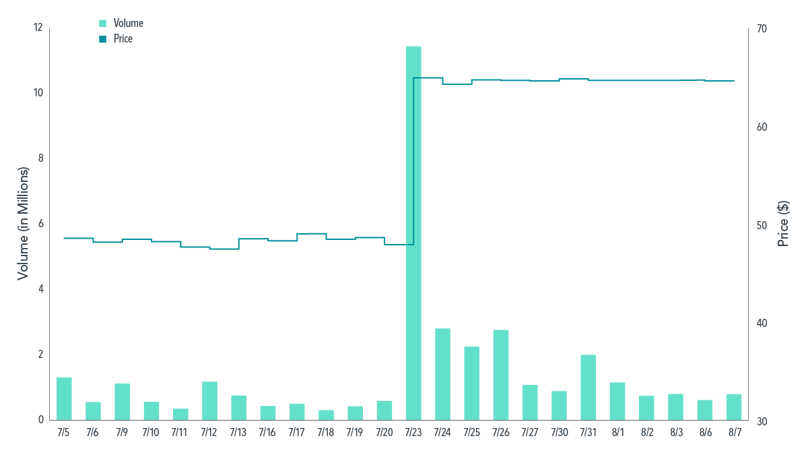Who Is Buying if So Many People Are Selling?
FOR CLIENTS
Amyr Rocha Lima, CFP®
9/18/20223 min read
In other words, after news of the impending sale hit the market, the supply and demand for the stock met at a new equilibrium price.
How should investors interpret and act on these signals?
Stock prices rise and fall based on a multiplicity of influences. And I believe that trying to untangle all these influences and profit from perceived mispricing is not possible in a systematic and scalable manner.
Here's an alternative approach:
Step #1 - Start by accepting that prices are fair and reflect the collective expectations of market participants.
While information frequently changes, this is quickly built into prices. Competition among buyers and sellers is such that it’s not possible to consistently outguess the market.
Step #2 - Fairly priced stocks can have different expected returns. The capital asset pricing model (CAPM) helps investors understand the returns they can expect given the level of risk they assume. And we can use this data to identify stocks in companies that offer higher expected returns.
Step #3 - build highly diversified portfolios around these broad drivers of return, while implementing your investment strategy efficiently and managing the cost of buying and selling into different funds.
Last, but not least, apply discipline and rebalance your portfolio to either stay within your chosen risk parameters or to adjust for changes in circumstances.
Ultimately, the stock market is like a giant information processing machine. All the influences mentioned above are constantly being assessed by millions of participants, and prices adjust based on those collective expectations.
The returns we expect from investing do not necessarily show up every day, every week, every month, or even every year. But the longer we stay invested, the more likely we are to capture them.
But, rest assured: even when prices are falling, people are still buying.
The market is doing its job, and I believe the rewards will be there if you remain disciplined.
Amyr Rocha Lima, CFP® is a financial planner who specialises in working with successful professionals age 50+ to help them reduce taxes, invest smarter and retire on their terms.
"Sellers were out in force on the market today after negative news on the economy."
It's a common line in TV finance reports. But have you ever wondered who is buying if so many people are selling?
The notion that sellers can outnumber buyers on down days doesn’t make sense. What the newscasters should say, of course, is that prices adjusted lower because would-be buyers weren’t prepared to pay the former price.
What happens in such a case is either a)the would-be sellers sit on their shares, or b)prices quickly adjust to the point where supply and demand come into balance and transactions occur at a price that both buyers and sellers find mutually beneficial. Economists refer to this as equilibrium.
But, the price at which equilibrium is reached can change.
That’s because new information is coming into the marketplace continually, forcing would-be sellers and would-be buyers to constantly adjust their expectations.
That new information might be company-specific news on earnings. It might be news that has implications for specific industries - like a spike in oil prices. Or it might be an economic development that affects the entire market, like a change in the unemployment rate.
Given this constant flux in the flow of news and information and the changing expectations of participants, it can be reassuring to remember that for everyone selling shares there must also be buyers of those shares - or the trade will never take place.
And whenever information changes, prices may change and quickly reach a new level of equilibrium.
For a simple example of how quickly prices adjust to new information, let's look at the trading activity by market participants in shares of a US-based health care provider.
It was reported in late July 2018 that a large private equity firm was in talks to purchase this particular health care firm at a price valuing the company at $65 per share. Prior to the announcement, shares of the firm were trading around $48.
As we see in the following graph, when the announcement broke, the market price for the stock adjusted overnight to just below $65.


”Amyr has been excellent in cutting through all the noise and simplifying our decision making for our future retirement plans."
Alexander Butt
(Head of Risk Management, Heathrow Airport)
*****
”Amyr has been a huge help to my wife and I in providing much needed reassurance in relation to our financial planning. For honest, high integrity financial advice, I strongly recommend him.”
William Baker
(Merit Researcher, Royal Botanic Gardens)
*****
”I found the whole financial planning process an informative, enlightening and pleasant experience, and I would like to thank Amyr for his efforts”
Martin Bulmer
(Professor of Sociology, University of Surrey)
*****
Here's what clients say
Let's chat
Ready to start building your financial plan?
Then you can book a free, no obligation call with me.
We'll have an initial conversation to better understand your requirements and to see whether my services would be a good fit.


Full Disclosure: Nothing on this site should ever be considered to be advice, research or an invitation to buy or sell any financial products.
Copyright © 2025, Amyr Rocha Lima
Free Guide
Let's Connect
Chartered Financial Planner | Kingston upon Thames

